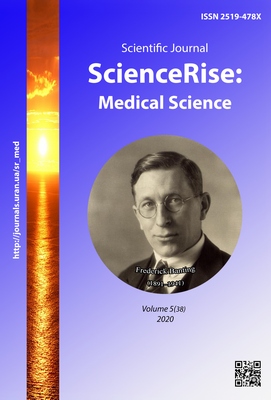Energy of blood circulation in primary reduction of myocardial contractility
DOI:
https://doi.org/10.15587/2519-4798.2020.213516Keywords:
circulatory energy, heart failure, acute coronary syndrome, coronary artery bypass graftingAbstract
The aim: to study the energy parameters of the circulatory system in heart failure in patients with acute coronary syndrome (ACS) against the background of coronary artery bypass grafting (CABG), depending on the degree of myocardial contractility decrease.
Materials and methods. In 48 patients with ACS in the perioperative period energy parameters of blood circulation have been determined: flow power (FP), oxygen reserve (OR) and circulatory reserve (CR). FP reflects the useful power of the myocardium, OR – the correspondence of oxygen absorption by tissues to their needs, CR is an integral energy parameter. Patients have been divided into 2 groups: group CF1 (n = 18) – patients with an ejection fraction (EF) of less than 40 %, group CF2 (n = 30) – patients with EF of at least 40 %. The same treatment has been performed in both groups.
Results. The initial energy parameters of circulation were significantly reduced, more so in the CF1 group. During treatment, FP, OR, and CR in the CF1 group increased more slowly than in the CF2 group, and remained significantly lower by the end of the study. The initial CR was highly correlated with the need for dobutamine, the duration of postoperative artificial blood circulation, and postoperative mechanical ventilation, so CR can also be used as a predictive criterion.
Conclusions. Determination of energy indicators of blood circulation allows you to fully assess the state of the circulatory system, predict the course of its insufficiency and monitor the effectiveness of its treatment. The severe decrease in myocardial contractility, accompanied by a decrease in the EF to 40 % or lower, slows down the recovery of energy parameters of circulation and requires the search for more effective methods of intensive therapy
References
- Ivanov, K. P. (2016). Novye biologicheskie problemy v energetike zhivykh sistem. Uspekhi sovremennoi biologii, 136 (6), 586–592.
- Ivanov, K. P. (2008). Energiia i zhizn. Uspekhi sovremennoi biologii, 128 (6), 606–619.
- Riabov, G. A. (1988). Gipoksiia kriticheskikh sostoianii. Moscow: Meditsina, 288.
- Rashmer, R. F.; Kositskii, G. I. (1981). Dinamika serdechno-sosudistoi sistemy. Moscow: Meditsina, 600.
- Folkov, B., Nil, E. (1976). Krovoobraschenie. Moscow: Meditsina, 463.
- Eagle, K. A., Guyton, R. A., Davidoff, R., Edwards, F. H., Ewy, G. A., Gardner, T. J. et. al. (2004). ACC/AHA 2004 Guideline Update for Coronary Artery Bypass Graft Surgery: Summary Article. Journal of the American College of Cardiology, 44 (5), 1146–1154. doi: http://doi.org/10.1016/j.jacc.2004.07.021
- Mykhnevych, K. H., Volkova, Yu. V., Khartanovych, M. V., Lyzohub, M. V. (2020). Enerhetychni aspekty krovoobihu. Kharkiv: TOV «Planeta-Prynt», 165.
- Mykhnevych, K. G., Volkova, Y. V., Baranova, N. V., Boiko, O. V. (2020). Determination of reference values of energy parameters of circulation. Ukraïnsʹkij Žurnal Medicini, Bìologìï Ta Sportu, 5 (4 (26)), 182–188. doi: http://doi.org/10.26693/jmbs05.04.182
- Usenko, L. V., Shifrin, G. A. (2007). Intensivnaia terapiia pri krovopotere. Dnepropetrovsk: Novaia ideologiia, 290.
- Mikhnevich, K. G. (2018). Some questions of hydrodynamics and energetics of circulatory and hemic links of the oxygen transport system (part 3). Emergency medicine, 6 (93), 28–34. doi: http://doi.org/10.22141/2224-0586.6.93.2018.147639
Downloads
Published
How to Cite
Issue
Section
License
Copyright (c) 2020 Kostiantyn Mykhnevych

This work is licensed under a Creative Commons Attribution 4.0 International License.
Our journal abides by the Creative Commons CC BY copyright rights and permissions for open access journals.
Authors, who are published in this journal, agree to the following conditions:
1. The authors reserve the right to authorship of the work and pass the first publication right of this work to the journal under the terms of a Creative Commons CC BY, which allows others to freely distribute the published research with the obligatory reference to the authors of the original work and the first publication of the work in this journal.
2. The authors have the right to conclude separate supplement agreements that relate to non-exclusive work distribution in the form in which it has been published by the journal (for example, to upload the work to the online storage of the journal or publish it as part of a monograph), provided that the reference to the first publication of the work in this journal is included.









